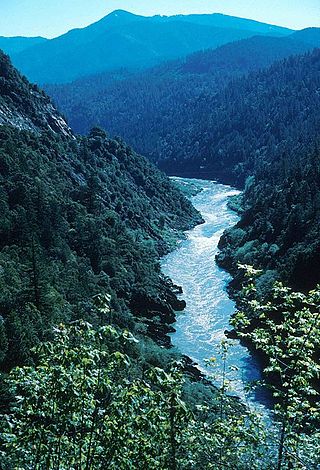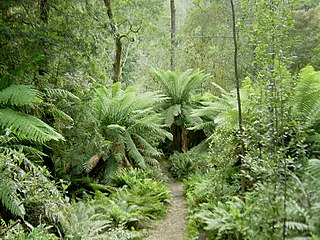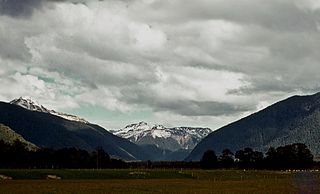Related Research Articles

Issaquah is a city in King County, Washington, United States. The population was 40,051 at the 2020 census. Located in a valley and bisected by Interstate 90, the city is bordered by the Sammamish Plateau to the north and the "Issaquah Alps" to the south. It is home to the headquarters of the multinational retail company Costco Wholesale Corporation. Issaquah is included in the Seattle metropolitan area.

Aldo Leopold was an American writer, philosopher, naturalist, scientist, ecologist, forester, conservationist, and environmentalist. He was a professor at the University of Wisconsin and is best known for his book A Sand County Almanac (1949), which has been translated into fourteen languages and has sold more than two million copies.

The Klamath River is a 257-mile (414 km) long river in southern Oregon and northern California. Beginning near Klamath Falls in the Oregon high desert, it flows west through the Cascade Range and Klamath Mountains before reaching the temperate rainforest of California's North Coast, where it empties into the Pacific Ocean. The Klamath River is the third-largest salmon and steelhead producing river on the west coast of the contiguous United States. The river's watershed – the Klamath Basin – encompasses more than 15,000 square miles (39,000 km2), and is known for its biodiverse forests, large areas of designated wilderness, and freshwater marshes that provide key migratory bird habitat.

National parks of Canada are vast natural spaces located throughout the country that are protected by Parks Canada, a government agency. Parks Canada manages the National Parks and Reserves in order to protect and preserve the Canadian wildlife and habitat that fall within the ecosystems of the park, keep them safe, educate visitors, and ensure public enjoyment in ways that do not compromise the area for future generations. The areas that fall within Parks Canada's governance include a wide range of protected areas, encompassing National Historic Sites, National Marine Conservation Areas (NMCA), and National Park Reserves. Canada established its first national park in Banff in 1885, and has since expanded its national park system to include 37 national parks and 11 national park reserves.
Forest & Bird, also known by its formal name as the Royal Forest and Bird Protection Society of New Zealand, is an environmental organisation specialising in the protection and conservation of New Zealand's indigenous flora and fauna and unique wild places and natural ecosystems. Forest & Bird consists of 47 branches located in urban and rural centres throughout New Zealand. Branches are actively engaged in conservation projects and advocacy on a community, regional and national basis. Forest & Bird has offices and staff located in Auckland, Christchurch, Wellington, Nelson and Dunedin. Forest & Bird publishes a quarterly magazine Forest & Bird, one of New Zealand's definitive natural history and conservation publications.

The Progressive Green Party was an environmentalist political party in New Zealand in the 1990s. It was a "blue-green" party – that is, one that is economically right-wing ("blue"), rather than left-wing ("red"), as well as environmentalist ("green").
This is a timeline of environmental history of New Zealand. It includes notable events affecting the natural environment of New Zealand as a result of human activity.
The Ecologic Foundation is an environmental organisation in New Zealand.

The Australian Conservation Foundation (ACF) is Australia's national environmental organisation, launched in 1965 in response to a proposal by the World Wide Fund for Nature for a more co-ordinated approach to sustainability.

Conservation in New Zealand has a history associated with both Māori and Europeans. Both groups of people caused a loss of species and both altered their behaviour to a degree after realising their effect on indigenous flora and fauna.

The Tarkine, officially takayna / the Tarkine, is an area containing the Savage River National Park in the north west Tasmania, Australia, which contains significant areas of wilderness. The Tarkine is noted for its beauty and natural values, containing the largest area of Gondwanan cool-temperate rainforest in Australia, as well as for its prominence in Tasmania's early mining history. The area's high concentration of Aboriginal sites has led to it being described by the Australian Heritage Council as "one of the world's great archaeological regions".

Sawtooth National Forest is a National Forest that covers 2,110,408 acres in the U.S. states of Idaho and Utah. Managed by the U.S. Forest Service in the U.S. Department of Agriculture, it was originally named the Sawtooth Forest Reserve in a proclamation issued by President Theodore Roosevelt on May 29, 1905. On August 22, 1972, a portion of the forest was designated as the Sawtooth National Recreation Area (SNRA), which includes the Sawtooth, Cecil D. Andrus–White Clouds, and Hemingway–Boulders wilderness areas. The forest is managed as four units: the SNRA and the Fairfield, Ketchum, and Minidoka Ranger Districts.

The Great Bear Rainforest is a temperate rain forest on the Pacific coast of British Columbia, comprising 6.4 million hectares. It is part of the larger Pacific temperate rainforest ecoregion, which is the largest coastal temperate rainforest in the world.

The Yurok people are an Algic-speaking Indigenous people of California that has existed along the Hehlkeek 'We-Roy or "Health-kick-wer-roy" and on the Pacific coast, from Trinidad south of the river’s mouth almost to Crescent City along the north coast.
The Conservation Council of Western Australia is the umbrella body for conservation groups and organisations in Western Australia. It has been the co-ordinator, publisher and guiding body for issues of woodchipping in the South West of Western Australia, the logging of old growth forests, as well as providing input into government processes involved with all aspects of environmental protection and conservation.
The Maruia Declaration was a public petition calling for the immediate phasing out of the logging of virgin native forest in New Zealand.

Maruia is a locality in the West Coast region of New Zealand. The Shenandoah Highway passes through it. Murchison is 65 km north, the Lewis Pass is 39 km to the south-east, and Reefton is 63 km west by road. The Maruia River flows past to the west.

The Butte Creek Ecological Preserve and Butte Creek Canyon Ecological Reserve consist of 2 distinct management units, the Preserve, aka the "Honey Run Unit" 93 acres (0.38 km2) owned and managed by the Chico State Research Foundation, and the "Virgin Valley" and "Canyon" Units 287 acres (1.16 km2), owned and managed by the California Department of Fish and Wildlife. The units are located east of Chico along Butte Creek in northern California. This stretch of Butte Creek is spawning habitat for the largest population of Central Valley spring-run Chinook salmon, an evolutionarily significant unit that is listed as threatened under the Endangered Species Act. Fall-run Chinook salmon and steelhead trout also spawn in the creek.
Friends of Clayoquot Sound is a Canadian grassroots non-profit environmental organization, based in Tofino, British Columbia. It focuses on protecting Clayoquot Sound's globally rare ecosystem of temperate rainforest and ocean, and on building a local, conservation-based economy.
References
- ↑ "History of Ecologic". Ecologic Foundation. Archived from the original on 12 October 2016.
- ↑ "Moratorium on park drilling sought". The Press . 5 December 1985. p. 72. Retrieved 16 November 2024.
- ↑ "Threat of large-scale mining acknowledged". The Press . 8 January 1986. p. 23. Retrieved 16 November 2024.